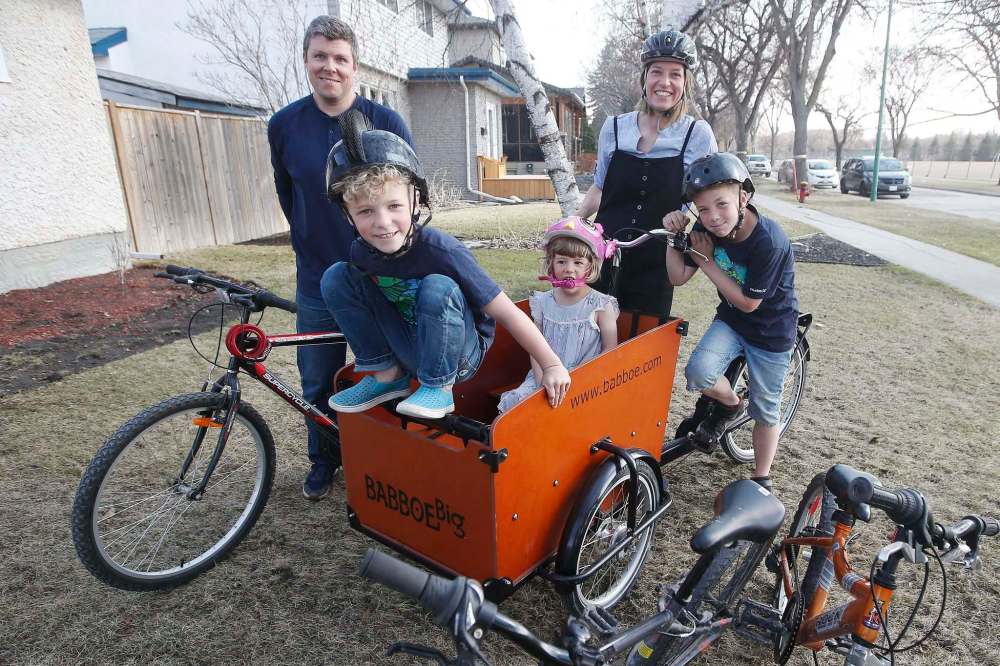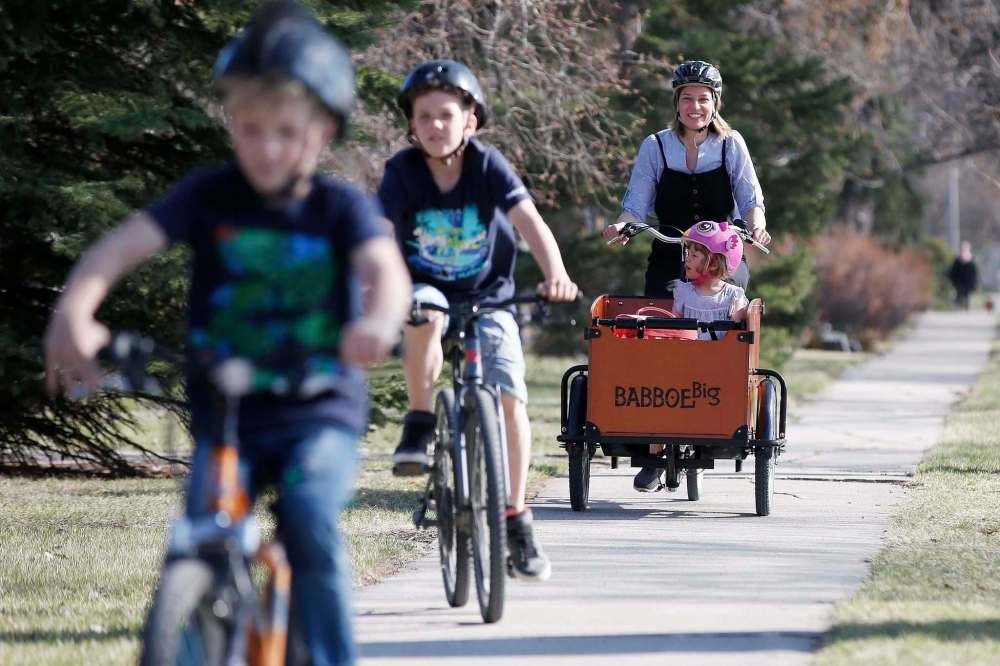Creativity cultivates green game-changers
Small steps by whole family lead to more sustainable lifestyle
Advertisement
Read this article for free:
or
Already have an account? Log in here »
To continue reading, please subscribe:
Monthly Digital Subscription
$1 per week for 24 weeks*
- Enjoy unlimited reading on winnipegfreepress.com
- Read the E-Edition, our digital replica newspaper
- Access News Break, our award-winning app
- Play interactive puzzles
*Billed as $4.00 plus GST every four weeks. After 24 weeks, price increases to the regular rate of $19.00 plus GST every four weeks. Offer available to new and qualified returning subscribers only. Cancel any time.
Monthly Digital Subscription
$4.75/week*
- Enjoy unlimited reading on winnipegfreepress.com
- Read the E-Edition, our digital replica newspaper
- Access News Break, our award-winning app
- Play interactive puzzles
*Billed as $19 plus GST every four weeks. Cancel any time.
To continue reading, please subscribe:
Add Free Press access to your Brandon Sun subscription for only an additional
$1 for the first 4 weeks*
*Your next subscription payment will increase by $1.00 and you will be charged $16.99 plus GST for four weeks. After four weeks, your payment will increase to $23.99 plus GST every four weeks.
Read unlimited articles for free today:
or
Already have an account? Log in here »
Hey there, time traveller!
This article was published 03/05/2021 (1637 days ago), so information in it may no longer be current.
Meghan Cameron and her family hope paying attention to the small things today will lead to bigger changes down the road.
Cameron, a Winnipeg mom of three whose family has been living a greener lifestyle for the last few years, says she started to be more conscious of her family’s spending after her second child was born.
That meant making smart environmental choices — recycling, reducing and reusing, which also help to save money, energy and natural resources — and turning them into habits.

“We didn’t want to be such consumers,” she says. “It’s been a gradual process.”
A 2020 global survey by Accenture, a Dublin-based management consultancy firm, found that 60 per cent of consumers reported making more environmentally friendly, sustainable or ethical purchases since the start of the pandemic.
Cameron says being eco-friendly doesn’t have to be complicated.
“We meal-plan and try not to waste any food. If there are leftovers, we eat them the next day or transform them into something else,” she says.
Cameron’s family took a valiant, yet unsuccessful, stab at composting and now use Compost Winnipeg through the Green Action Centre, which collects, composts and tracks organic waste from residents and businesses.
“(They) pick it up on a weekly basis. We find so much of our garbage is compostable. We had no idea how much it reduced our total garbage,” she says. “There’s a bucket full of things that can be composted and turned into soil.”
Composting also presented Cameron with a teachable moment — to educate her kids about food’s environmental impact.
“Now, when we clear the dishes, the kids understand what can go into the compost bin and what happens to our food scraps,” she says. “We used to just throw everything in the garbage and not give a moment’s notice. Now, we sort through it.”
According to the Green Action Centre, composting organic material produced at your home, work and school can divert up to 40 per cent of your waste stream. The finished compost is also a valuable resource that can improve soil ecology.
“Composting keeps greenhouse gases out of our atmosphere by not sending food to the landfills. It also benefits our gardens as it adds nutrients to plants and helps them grow and suppress diseases,” says Lea Coté, its composting program co-ordinator.
Another habit Cameron has changed is driving.
“I got sick of driving my kids to school and we have just one car so we decided to invest in a cargo bike,” says the mother of three kids under the age of eight.
That was a significant investment for the Cameron family but where there’s a will there’s a way.
“We saved our money and I sold my wedding dress on Kijiji,” she says.

Cameron has even used her cargo bike to transport all three of her kids — at the same time.
“There are benches and seat belts for the kids. When they were younger, I had all three of them in there and would drive them back and forth from school. I found so many uses for it,” she says. “If I coach soccer, I throw the soccer balls in there. I also take it to the grocery store and garden centre.”
Cargo bikes are specifically designed to be sturdy enough to carry heavy loads and often two or more people. They vary in size and usually have a longer wheelbase than a standard bicycle with space for hauling cargo either in the front or back. The bikes can be accessorized to fit specific carrying needs, such as adding child bike seats.
Cameron says it’s an easy, environmentally friendly way to get around without the hassle and expense of driving and finding parking.
A recent study out of Concordia University in Montreal found the volumes of air pollutants were far lower in several large Canadian cities in August 2020 than than they were in previous summers.
The findings, which were published in the journal Science of the Total Environment, were based on air quality readings from monitoring stations in Vancouver, Edmonton, Winnipeg, Montreal, Toronto, Saskatoon, Halifax and St. John’s, as well as data on traffic congestion and fuel consumption.
When it comes to plastics and excessive waste, Cameron didn’t realize just how much her family was throwing away until her kids began Forest School at FortWhyte Alive — a program that connects children with nature and fosters learning through exploring the outdoors.
“FortWhyte promotes litterless lunches and it was a total game-changer for us,” Cameron says. “I used to buy cheese strings and single-serve yogurts, but that’s excess waste in children’s lunches. It really made me aware of how much plastic was coming in and out of our lives. I don’t buy single-serve items anymore. To think all that plastic sits in our landfills for hundreds of years.”
Now, she gets creative with school lunches and incorporates home baking along with fruits and vegetables.
“Our lunches are very simple but I think it’s really important,” she says. “We say, ‘let’s reduce plastic’ but we also have to show kids how to do it.”
The campaign to gain control of plastic waste is one of the world’s fastest-growing environmental movements. According to a federal government study last year, more than one-third of plastics produced in Canada are for single-use packaging or products — such as plastic bags, take-out containers and bottle caps — and they make up one of the largest sources of plastics found in freshwater.
Last fall, Ottawa announced a ban of six single-use plastic items that are set to be phased out across the country by 2022. They are: plastic grocery bags, stir sticks, plastic cutlery, straws, six-pack rings and food containers made from hard-to-recycle plastics.
Coté says if you want to start reducing plastic, evaluate the plastic you find in your home by laying it all out in front of you.
“Select items to eliminate and stick to it. Maybe you can get rid of plastic straws or replace single use coffee pods with refillable ones,” she says. “Or maybe it’s plastic waste associated with take-out food. Each action goes a long way to moving forward in the right direction.”

Not all of Cameron’s green lifestyle changes were necessarily conscious efforts.
“Our dryer broke and we didn’t have the money to buy a new one so we started hanging our clothes,” she says. “It takes more time but now we just hang our clothes. We never replaced the dryer. I would’ve never done it if my dryer hadn’t stopped working.”
One of the best things you can do for the environment is to cut back on buying new things by sourcing things secondhand.
“I want my kids to know that secondhand isn’t a lesser thing. Secondhand is just as good or better than going to a store and buying brand new off the shelf,” Cameron says. “Some moms I know lend baby items for a period of time until they need them again. You don’t need to own every single thing. Our houses are only so big.”
Making the commitment to go green is an important step in protecting the environment but where do you begin? Coté suggests starting small and building from there.
“Start by picking an action that will help our environment and then build that into your routine so it’s second nature,” she says. “Once you have that established, pick a new action and add it into your life.”
These kinds of lifestyle changes don’t happen overnight. Developing a sense for sustainability takes time — and now might be the best time to cultivate it.
“It’s about making conscious decisions in our home of what we bring in,” Cameron says. “Once you’re on your green journey, you start to recognize little changes you can make.”
sabrinacarnevale@gmail.com
@SabrinaCsays

Sabrina Carnevale is a freelance writer and communications specialist, and former reporter and broadcaster who is a health enthusiast. She writes a twice-monthly column focusing on wellness and fitness.
Our newsroom depends on a growing audience of readers to power our journalism. If you are not a paid reader, please consider becoming a subscriber.
Our newsroom depends on its audience of readers to power our journalism. Thank you for your support.

